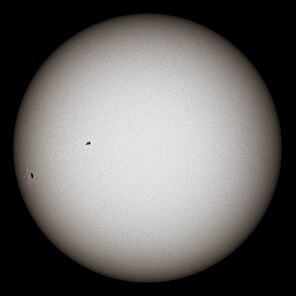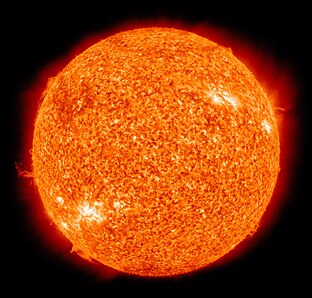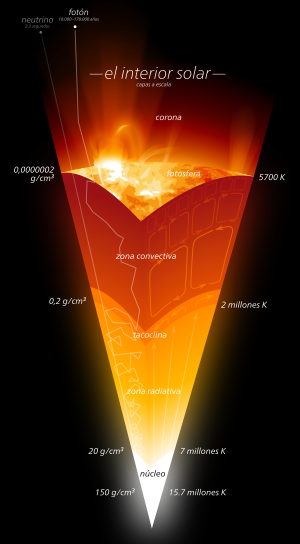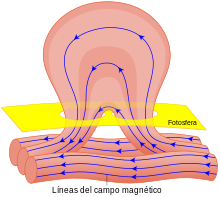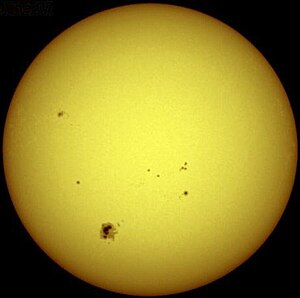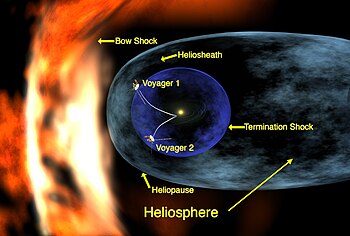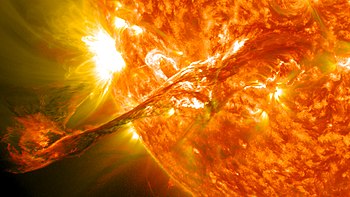Sun
The Sun (from the Latin sol, solis, 'god Sol invictus' or 'sol', in turn from the Proto-Indo-European root sauel-, 'to shine') is a G-type star of the main sequence and luminosity class V that is located in the center of the solar system and constitutes the largest source of electromagnetic radiation in this planetary system. It is an almost perfect sphere of plasma, with an internal convective movement that generates a magnetic field through a dynamo process. About three quarters of the Sun's mass consists of hydrogen; the rest is mostly helium, with much smaller amounts of elements, including oxygen, carbon, neon, and iron.
It was formed approximately 4.6 billion years ago from the gravitational collapse of matter within a region of a large molecular cloud. Most of this matter accumulated in the center, while the rest flattened out into an orbiting disk that became the solar system. The central mass became increasingly dense and hot, eventually leading to the initiation of nuclear fusion at its core. It is believed that almost all stars are formed by this process. The Sun is more or less of intermediate age and has not changed drastically for more than four billion years, and will remain fairly stable for another 5 billion years. However, after the hydrogen fusion in its core has stopped, the Sun will undergo major changes and become a red giant. The Sun is estimated to become large enough to engulf the current orbits of Mercury, Venus, and possibly Earth.
Earth and other bodies (including other planets, asteroids, meteoroids, comets, and dust) orbit the Sun. It alone accounts for about 99.86% of the mass of the solar system. Sun to Earth was exactly defined by the International Astronomical Union to be 149 597 870 700 meters (approximately 150 million kilometers). Its light travels this distance in 8 minutes and 20 seconds.
Energy from the Sun, in the form of sunlight, sustains nearly all life on Earth through photosynthesis, and determines Earth's climate and weather.
It is the star of the planetary system in which the Earth is located; therefore, it is the star with the greatest apparent brightness. Its visibility in the local sky determines, respectively, day and night in different regions of different planets. On Earth, the energy radiated by the Sun is used by the photosynthetic beings that constitute the base of the trophic chain, thus being the main source of energy for life. It also provides the energy that keeps climate processes going.
The Sun is a star that is in the phase called the main sequence, with a spectral type G2 and luminosity class V, therefore, it is also called a yellow dwarf. It formed between 4,567.9 and 4,570.1 million years ago and will remain on the main sequence for approximately 5 billion more years. The Sun, together with all the celestial bodies that orbit around it, including the Earth, make up the solar system.
Despite being a dwarf star, it is the only one whose shape can be seen with the naked eye, with an angular diameter of 32′35″ arc at perihelion and 31′31″ at aphelion, which gives a average diameter of 32′03″. The combination of sizes and distances of the Sun and the Moon are such that they appear to be approximately the same apparent size in the sky. This allows for a wide range of different solar eclipses (total, annular, or partial).
The vast effect of the Sun on the Earth has been recognized since prehistoric times and the star has been considered by some cultures as a deity. The movement of the Earth around the Sun is the basis of the solar calendar, which is the predominant calendar in use today.
The scientific discipline that deals with the study of the Sun in its entirety is solar physics.
Features
The Sun is a main sequence G-type star that encompasses approximately 99.86% of the mass of the solar system. The Sun has an absolute magnitude of +4.83, estimated to be brighter than 85% of the stars in the Milky Way, most of which are red dwarfs. The Sun belongs to Population I, or stars rich in heavy elements. The formation of the Sun may have been caused by shock waves from one or more nearby supernovae. This was raised due to the great abundance of heavy elements in the solar system, such as gold and uranium, in relation to the abundances of these elements in the so-called Population II stars, these being poor in heavy elements. These elements could have been produced by endothermic nuclear reactions during a supernova, or by transmutation through neutron absorption within a massive second-generation star.
The Sun is by far the brightest object in the sky, with an apparent magnitude of −26.74. It is about 13 billion times brighter than the second most luminous star, Sirius, which has an apparent magnitude of −1.46. The average distance from the center of the Sun to the center of the Earth is about 1 astronomical unit (about 150 million kilometers), although the distance varies as the Earth moves from perihelion in January to aphelion in July. Over this average distance, light travels from the Sun's horizon to Earth's horizon in about 8 minutes and 19 seconds, while light from the closest points of the Sun and Earth takes about two seconds less.
The Sun does not have a defined limit and in its external parts its density decreases exponentially with increasing distance from its center. However, for measurement purposes, the solar radius is considered as the distance that encompasses from its center to the edge of the photosphere, the apparent visible surface of the Sun. Based on this measurement, the Sun is an almost perfect sphere with a estimated flattening of 9 millionths, meaning that its polar diameter differs from its equatorial diameter by only 10 kilometers. The tidal effect of the planets is weak and does not significantly affect the shape of the Sun. The Sun rotates faster at its equator than at its poles. This differential rotation is caused by convective motion due to heat transport and the Coriolis effect produced by the Sun's rotation. In a reference frame defined by the stars, the rotation period is approximately 25.6 days at the equator. and 33.5 days at the poles. Viewed from Earth in its orbit around the Sun, the apparent rotation period of the Sun at its equator is about 28 days.
Sunlight
The solar constant is the amount of energy that the Sun deposits per unit of time and area and that is directly exposed as sunlight. The solar constant is equal to approximately 1361 W/m² (watts per square meter) at a distance of one astronomical unit (au) from the Sun (i.e., on or at the same distance from Earth as Earth). Light of the Sun at the Earth's surface is attenuated by the Earth's atmosphere, so that less energy reaches the surface (about 1000 W/m²) in bright conditions when the Sun is near the zenith. Light from the Sun at the top of Earth's atmosphere is composed (by total energy) of approximately 50% infrared light, 40% visible light, and 10% ultraviolet light. Earth's atmosphere filters more than 70% of the sun's ultraviolet radiation, especially at shorter wavelengths. Solar ultraviolet radiation ionizes the upper part of the atmosphere on Earth's day side, making the ionosphere electrically conductive.
The color of the Sun is white with a color-space index (CIE) close to (0.3; 0.3) when viewed from space or high in the sky; On the other hand, when observed from a low zone of the sky, the atmospheric scattering of the Sun has a yellow, red, orange and magenta color. Despite its typical whiteness, most people picture the Sun as yellow; the reasons for this are debated. The Sun is a G2V star, with G2 indicating that its surface temperature is about 5778 K (5505 °C), and V that, like most stars, is a main sequence dwarf star. The Sun's average luminance is about 1.88 Gcd/m² (gigacandelas per square meter), but as seen through Earth's atmosphere, this drops to about 1.44 Gcd/m². However, the luminance is not constant across the Sun's disk (limb darkening).
Composition
The Sun is composed primarily of the chemical elements hydrogen and helium; representing 74.9% and 23.8% of the Sun's mass in the photosphere, respectively. All of the heavier elements, called metals in astronomy, make up less than 2% of the mass, with oxygen (plus or minus 1% of the Sun's mass), carbon (0.3%), neon (0.2 %), and iron (0.2%), which is the most abundant.
The Sun inherited its chemical composition from the interstellar medium through which it formed. Hydrogen and helium in the Sun were produced by Big Bang nucleosynthesis, and the heavier elements were created by stellar nucleosynthesis in generations of stars that completed their stellar evolution and returned their material to the interstellar medium before the Sun's formation. The chemical composition of the photosphere is normally considered to be representative of the composition of the primordial solar system. However, since the Sun formed, some helium and heavy elements have gravitationally settled from the photosphere. Therefore, in today's photosphere, the helium fraction is small, and the metallicity is only 84% of what it was in the protostellar phase (before nuclear fusion began in the core). The Sun's protostellar composition is thought to have been 71.1% hydrogen, 27.4% helium, and 1.5% heavier elements.
Today nuclear fusion in the Sun's core has changed the composition by converting hydrogen to helium, so the innermost part of the Sun is now about 60% helium, along with the abundance of heavier elements that have not been altered. Because heat is transferred from the center of the Sun by radiation rather than convection, none of the core fusion products have reached the photosphere.
The core's "hydrogen burning" reactive zone, where hydrogen is converted to helium, is beginning to be surrounded by an inner core of "helium ash." This development will continue and later the Sun will rise from the main sequence to become a red giant.
The abundances of solar heavy elements described above are measured using both spectroscopy of the Sun's photosphere and by measuring the abundances in meteorites that have never been heated to melting temperatures. These meteorites are thought to retain the composition of the protostellar Sun and are therefore unaffected by heavy element deposition. Generally, the two methods agree well.
Sun Structure
Like all stars, the Sun has a spherical shape, and because of its slow rotation, it also has a slight polar flattening. As in any massive body, all the matter that constitutes it is attracted towards the center of the object by its own gravitational force. However, the plasma that forms the Sun is in equilibrium, since the increasing pressure in the solar interior compensates the gravitational attraction, which generates a hydrostatic equilibrium. These enormous pressures are produced due to the density of the material in its nucleus and the enormous temperatures that occur in it thanks to the thermonuclear reactions that take place there. There is, in addition to the purely thermal contribution, one of photonic origin. This is the radiation pressure, not insignificant, which is caused by the enormous flow of photons emitted in the center of the Sun.
Almost all terrestrial chemical elements (aluminum, sulfur, barium, cadmium, calcium, carbon, cerium, cobalt, copper, chromium, tin, strontium, gallium, germanium, helium, hydrogen, iron, indium, magnesium, manganese, nickel, nitrogen, gold, oxygen, palladium, silver, platinum, lead, potassium, rhodium, silicon, sodium, thallium, titanium, tungsten, vanadium, zirconium, and zinc) and various compounds (such as cyanogen, carbon dioxide, and ammonia) have been identified in the constitution of the sun king, so it has been concluded that, if our planet warmed up to solar temperature, it would have a luminous spectrum almost identical to the Sun. Even helium was first discovered in the Sun and then their presence on our planet was confirmed.
The Sun has a structure in spherical layers or "onion layers". The physical border and the chemical differences between the different layers are difficult to establish. However, a physical function can be determined that is different for each of the layers. At present, astrophysics has a model of solar structure that satisfactorily explains most of the observed phenomena. According to this model, the Sun is made up of: 1) solar core, 2) radiant zone, 3) convective zone, 4) photosphere, 5) chromosphere, 6) corona, 7) sunspots, 8) granulation, and 9) solar wind..
Core
It occupies about 139,000 km of the solar radius, 1⁄5 of it, and it is in this area where the thermonuclear reactions that provide all the energy that the Sun produces take place. This energy generated in the core of the Sun takes a million years to reach the solar surface. In its center it is estimated that there is 49% hydrogen, 49% helium and 2% that is distributed in other elements that serve as catalysts in thermonuclear reactions. In the early 1930s, the Austrian physicist Fritz Houtermans (1903-1966) and the English astronomer Robert d'Escourt Atkinson (1898-1982) joined their efforts to find out if the energy production in the interior of the Sun and in the stars could be explained by nuclear transformations. In 1938, Hans Albrecht Bethe (1906-2005) in the United States and Carl Friedrich von Weizsäcker (1912-2007) in Germany simultaneously and independently found the remarkable fact that a group of reactions involving the carbon and nitrogen as catalysts constitute a cycle, which is repeated over and over again, as long as hydrogen lasts. This group of reactions is known as the Bethe or carbon cycle, and is equivalent to the fusion of four protons in a helium nucleus. In these fusion reactions there is a loss of mass, that is, the consumed hydrogen weighs more than the produced helium. This difference in mass is transformed into energy, according to Einstein's equation (E = mc²), where E is energy, m is mass and c is the speed of light. These nuclear reactions transform 0.7% of the affected mass into photons, with a very short wavelength and, therefore, very energetic and penetrating. The energy produced maintains the thermal equilibrium of the solar core at temperatures of approximately 15 million kelvins.
The cycle occurs in the following stages:
- 1H1 + 6C12 → 7N13
- 7N13 → 6C13 + e+ + neutrino
- 1H1 + 6C13 → 7N14
- 1H1 + 7N14 → 8O15
- 8O15 → 7N15 + e+ + neutrino
- 1H1 + 7N15 → 6C12 + 2He4.
- Adding all reactions and canceling common terms, you have
- 4 1H1 → 2He4 + 2e+ + 2 neutrinos = 26.7 MeV.
The net energy released in the process is 26.7 MeV, or about 6.7·1014 J per kg of protons consumed. The carbon acts as a catalyst, since it is regenerated at the end of the cycle.
Another fusion reaction that occurs in the Sun and stars is the Critchfield cycle, more commonly known as the proton-proton chain. Charles Critchfield (1910-1994) was a young physicist in 1938, a student of George Gamow, (1904-1968) at George Washington University, and he had a completely different idea, realizing that in the collision between two protons at velocities close to that of light, it can happen that one of them loses its positive charge (e+), merges and becomes a neutron, which remains attached to the other proton and forms a deuterium nucleus, that is, a heavy nucleus formed by a stable isotope of hydrogen. The positron (e+) when released tends to annihilate quite quickly, fusing with an electron (e-), producing photonic radiation in the process. At the same time, in this second phase, a low-energy electron neutrino is released, which does not interact with any atom and is released into space at speeds close to that of light without colliding with matter.
Later, the fusion of a proton (p+), or what is the same, an H1 nucleus, with a deuterium nucleus gives rise to a helium isotope He³ and to the emission of gamma (γ) photons. Finally, with approximately 97% probability, two nuclei of the He³ isotope give rise, when fused, to a stable nucleus of He4 plus two new protons (p+), with which the cycle ends. it feeds back to the first initial phase, while losing energy at the rate of 26.7 MeV net.
The reaction can occur in two somewhat different ways:
- 1H1 + 1H1 → 1H2 + e+ + electronic neutrino;
- 1H1 + 1H2 → 2He3 + gamma photons;
- 2He3 + 2He3 → 2He4 + 2 1H1.
- also expressed with the notation:
- p+ + p+ → H2 + e+ +.
- H2 + p+ → He3 + γ;
- He3 + He3 → He4 + p+ + p+
The first cycle occurs in stars that are hotter and more massive than the Sun, and the proton-proton chain in stars similar to the Sun. As for the Sun, until 1953 it was believed that its energy was produced almost exclusively by the Bethe cycle, but it has been shown in recent years that most of the solar heat (~75%) comes from the proton-proton cycle.
In the last stages of its evolution, the Sun will also fuse the helium produced by these processes to produce carbon and oxygen (see triple-alpha process).
Radiant zone
In the zone outside the nucleus, the transport of the energy generated inside is produced by radiation up to the outer limit of the radioactive zone. This zone is composed of plasma, that is, large amounts of ionized hydrogen and helium. As the temperature of the Sun decreases from the center (15 MK) to the periphery (6 kK in the photosphere), it is easier for any photon to move from the center to the periphery than vice versa. However, photons must travel through a tremendously dense ionized medium, being absorbed and re-emitted countless times on their way. It is estimated that any photon can take a million years to reach the surface and manifest as visible light.
Convective zone
This region extends above the radiant zone and in it the solar gases are no longer ionized and the photons are easily absorbed and become an opaque material to radiation transport. Therefore, the transport of energy is carried out by convection, so that the heat is transported in an inhomogeneous and turbulent way by the fluid itself. The fluids expand when they are heated and their density decreases. Therefore, ascending currents of material are formed from the hot zone to the upper zone, and simultaneously downward movements of material from the less hot outer zones are produced. Thus, at about 200 000 km under the Sun's photosphere, the gas becomes opaque due to the decrease in temperature; consequently, it absorbs the photons coming from the lower zones and heats up at the expense of their energy. Turbulent convective sections are thus formed, in which the parcels of hot and light gas rise up to the photosphere, where again the solar atmosphere becomes transparent to radiation and the hot gas gives up its energy in the form of visible light, and cools before descending back into the depths. The analysis of the solar oscillations has made it possible to establish that this area extends up to gas strata located at the depth indicated above. The observation and study of these solar oscillations constitute the field of work of helioseismology.
Photosphere
The photosphere is the visible area where visible light from the Sun is emitted. The photosphere is considered the solar "surface" and, seen through a telescope, appears to be made up of bright granules projected against a darker background. Because of the turmoil in our atmosphere, these granules seem to be always in turmoil. Since the Sun is gaseous, its photosphere is somewhat transparent: it can be observed to a depth of a few hundred kilometers before becoming completely opaque. Normally, the solar photosphere is considered to be about 100-200 km deep.
Although the edge or limb of the Sun appears quite sharp in a photograph or in the solar image projected with a telescope, it is easy to see that the brightness of the solar disk decreases towards the edge. This phenomenon of darkening from the center to the limb is a consequence of the fact that the Sun is a gaseous body with a temperature that decreases with the distance from the center. The light seen in the center comes from most of the lower layers of the photosphere, which is hotter and therefore more luminous. When looking towards the limb, the visual direction of the observer is almost tangent to the edge of the solar disk, which is why radiation comes mainly from the upper layers of the photosphere, which are less hot and emit less intensity than the deep layers at the base of the photosphere.
A photon takes an average of 10 days from the fusion of two hydrogen atoms, to cross the radiant zone and a month to travel the 200,000 km of the convective zone, using only about 8 and a half minutes in crossing the distance that separates the Earth from the Sun. It is not that photons travel faster now, but that outside the Sun the path of photons is not impeded by the continuous changes, shocks, breaks and turbulences that They experienced inside the Sun.
The bright granules in the photosphere are often hexagonal in shape and are separated by fine dark lines. The granules are evidence of the bubbling, convective motion of hot gases on the outer side of the Sun. In effect, the photosphere is a continuously boiling mass in which the convective cells are seen as moving granules whose half-life is only about nine minutes. The mean diameter of the individual granules is about 700 to 1,000 km and they are particularly noticeable in periods of minimal solar activity. There are also turbulent motions on a larger scale, the so-called “supergranulation”, with typical diameters of about 35 000 km. Each super pellet contains hundreds of individual pellets and survives for 12-20 hours. Richard Christopher Carrington (1826-1875), a brewer and amateur astronomer, first observed photospheric granulation in the 19th century. In 1896, the Frenchman Pierre Jules César Janssen (1824-1907) succeeded in photographing photospheric granulation for the first time.
The most obvious sign of activity in the photosphere are sunspots. In ancient times the Sun was considered a divine fire and therefore perfect and infallible. In the same way it was known that the bright face of the Sun was sometimes clouded with dark spots, but it was imagined that this was due to objects passing in the space between the Sun and the Earth. When Galileo (1564-1642) built the first astronomical telescope, giving rise to a new stage in the study of the Universe, he made the following statement: "Repeated observations have convinced me that these spots are substances on the surface of the Sol, in which they are produced continuously and in which they also dissolve, some sooner and others later». A typical sunspot consists of a dark central region, called an "umbra," surrounded by a lighter "penumbra." A single smudge can be as large as 12,000 km (almost as large as the diameter of the Earth), but a group of smudges can be 120,000 km in extent and sometimes even more. The penumbra is made up of a structure of light and dark filaments that extend more or less radially from the umbra.
Both (umbra and penumbra) appear dark by contrast with the photosphere, simply because they are cooler than the mean temperature of the photosphere. Thus, the umbra has a temperature of 4,000 K, while the penumbra reaches 5,600 K, lower in both cases than the 6,000 K that the granules of the photosphere have. By the Stefan-Boltzmann law, in which the total energy radiated by a black body (such as a star) is proportional to the fourth power of its effective temperature (E = σT4, where σ = 5.67051 10−8 W/m² K4), the umbra emits approximately 32% of the light emitted by an equal area of the photosphere and similarly the penumbra it has a brightness of 71% of the photosphere. The darkness of a sunspot is caused solely by a contrast effect; if we could see a standard spot, with an umbra the size of Earth, isolated and at the same distance as the Sun, it would shine 50 times brighter than the full Moon. The spots are relatively immobile with respect to the photosphere and participate in the solar rotation. The area of the solar surface covered by the spots is measured in terms of millionths of the visible disk.
Chromosphere
The chromosphere is a visually much more transparent outer layer to the photosphere. It is about 10,000 km in size, and it is impossible to observe it without special filters, as it is dwarfed by the brighter photosphere. The chromosphere can be observed during a solar eclipse in a characteristic reddish hue and at specific wavelengths, notably at Hα, a characteristic wavelength of very high-temperature hydrogen emission.
Solar prominences occasionally rise from the photosphere, reaching heights of up to 150,000 km and producing spectacular solar flares.
Sun Crown
The solar corona is made up of the thinnest layers of the sun's upper atmosphere. Its temperature reaches millions of kelvins, a figure much higher than that of the layer that follows it, the photosphere, this thermal inversion being one of the main enigmas of recent solar science. These very high temperatures are misleading data and a consequence of the high speed of the few particles that make up the solar atmosphere. Their high speeds are due to the low density of the coronal material, the intense magnetic fields emitted by the Sun and the shock waves that break on the solar surface stimulated by the convective cells. As a result of its high temperature, a large amount of X-ray energy is emitted from the corona. In reality, these temperatures are nothing more than an indicator of the high speeds reached by the coronal material that is accelerated along the magnetic field lines and in dramatic coronal material ejections (CMEs). The truth is that this layer is too thin to be able to speak of temperature in the usual sense of thermal agitation.
All these combined phenomena cause strange lines in the light spectrum that made us think of the existence of an unknown element on Earth that was even called coronium until later investigations in 1942 concluded that they were radiations produced by neutral oxygen atoms from the external part of the same crown, as well as highly ionized iron, nickel, calcium and argon (phenomena impossible to obtain in laboratories).
The solar corona is only observable from space with suitable instruments that display an opaque disk to artificially eclipse the Sun or during a natural solar eclipse from Earth. The tenuous material of the corona is continuously blown out by the strong solar radiation giving rise to a solar wind. Thus, the observed structures in the corona are thought to be largely shaped by the solar magnetic field and convective transport cells.
In 1970 the Swedish physicist Hannes Alfvén was awarded the Nobel Prize. He estimated that there were waves that carried energy along magnetic field lines that run through the plasma of the solar corona. But until today it had not been possible to detect the amount of waves that were necessary to produce said energy.
But high-definition ultraviolet images, taken every eight seconds by NASA's Solar Dynamics Observatory (SDO) satellite, have allowed scientists like Scott McIntosh and his colleagues at the US National Center for Atmospheric Research to detect large numbers of these waves. They propagate at high speed (between 200 and 250 km/s) in moving plasma. Waves whose energy flux is between 100 and 200 W/km² (watts per square kilometer) “are capable of providing the necessary energy to propel the fast solar winds and thus compensate for heat losses from the less agitated regions of the solar corona », the researchers estimate.
However, for McIntosh this is not enough to generate the 2000 W/m² (watts per square meter) needed to supply the active areas of the corona. This is why instruments with greater temporal and spatial capacity are required to study the entire spectrum of radiated energy in the active regions of our star.
Heliosphere
The heliosphere would be the region that extends from the Sun to beyond Pluto and is under the influence of the solar wind. It is in this region where the effects of geomagnetic storms extend and also where the influence of the solar magnetic field extends. The heliosphere protects the solar system from radiation from the interstellar medium and its limit extends to more than 100 AU from the Sun, a limit only exceeded by comets.
Solar activity
Coronal Mass Ejection
The coronal mass ejection (CME) is a wave made of radiation and solar wind that is ejected from the Sun in the period called Solar Maximum Activity. This wave is very dangerous as it damages electrical circuits, transformers and communication systems. When this happens, it is said that there is a solar storm.
- Every 11 years, the Sun enters a turbulent cycle (Maximum Solar Activity) which represents the most favorable time for the planet to suffer a solar storm. This process ends with the change of solar polarity (not confusing with the change of terrestrial polarity).
- We are in the Solar Cycle 25, which began in December 2019.
- A powerful solar storm is able to completely paralyze the power grid of the big cities, a situation that could last weeks, months or even years.
- Solar storms can cause interference in radio signals, affect air navigation systems, damage phone signals and completely unused satellites.
- On March 13, 1989, the city of Quebec, in Canada, was hit by a strong solar storm. As a result, six million people were affected by a large blackout that lasted 90 seconds. The Montreal power grid was paralyzed for more than nine hours. The damage caused by the blackout, along with the losses caused by the lack of energy, reached hundreds of millions of dollars.
- Between 1 and 2 September 1859, an intense solar storm affected most of the planet. The U.S. and northern European telegraphic lines were unused and several fires were triggered. In addition, an impressive boreal aurora, a phenomenon that can normally only be seen from the Arctic regions, could be seen in places so far away from the poles as southern Europe, the Caribbean, Hawaii., and even in Colombia, near the Earth equator.
Change of solar polarity
The magnetic field of the sun is formed as follows: In the nucleus, the pressures of hydrogen cause its atoms to be excluded only by the forces of polarity of the protons, leaving a cloud of electrons around said nucleus (the electrons have broken away from traditional orbits, forming a common electron radiation shell). The fusion of hydrogen atoms into helium occurs in the innermost part of the nucleus, where helium is restricted by being a heavier material. Said 'ordering' it induces the electrons themselves to share energy states and consequently their magnetic fields acquire even more density and power. The enormous forces of gravity prevent photons (carriers of these forces) from escaping freely. In this way, a powerful magnetic field is generated inside it that influences the dynamics of the plasma in the following layers.
The magnetic fields, as if it were a fluid material, find their dynamics due to the magnetohydrodynamic forces in constant interaction with the gravitational and rotational forces of the star, reaching the surface in such a way that the outermost materials remain ordered according to Gaussian lines of force. The solar rotation produces that the outermost layers do not all rotate at the same speed, so the ordering of these lines of force becomes unbalanced as the materials distributed between the poles and the equator lose synchronism in the rotational rotation of the star. For each break in the integrity of the magnetic field, there is an escape of Gauss lines of force (producing the typical black spots), in which an increase in these can result in a consequent solar flare due to the local disintegration of the Gauss field.. When the Sun approaches its maximum disorder, solar storms are at their maximum. These periods occur every 11 years. The sun does not have an electromagnetic field like Earth's, but rather has what is called the solar wind, produced by those rotational instabilities of the Sun. If it were not for that, the Sun's magnetic fields would be restricted to plasma dynamics.
For the same reason, a fusion reaction between two hydrogen atoms inside the Sun takes 11 years to escape the enormous gravitational and magnetic forces.
Birth and death of the Sun
The Sun formed 4.65 billion years ago and has fuel for another 7.5 billion years. After that, it will start to get bigger and bigger, until it becomes a red giant. Eventually it will sink under its own weight and become a white dwarf, which can take up to a billion years to cool down.
It formed from clouds of gas and dust that contained debris from previous generations of stars. Thanks to the metallicity of this gas, the planets, asteroids and comets of the solar system later arose from its circumstellar disk. Inside the Sun, fusion reactions take place in which hydrogen atoms are transformed into helium, producing the energy that it radiates. Currently, the Sun is in the middle of the main sequence, a phase in which it will continue for about 5 billion more years, stably fusing hydrogen.
Every second 700 million tons of hydrogen are transformed into helium ash, this process transforms five million tons of matter into energy, which results in the Sun becoming lighter and lighter.
There will come a day when the Sun uses up all the hydrogen in the central region, having transformed it into helium. The pressure will be unable to sustain the upper layers and the central region will tend to contract gravitationally, progressively heating the adjacent layers. The excess energy produced will cause the outer layers of the Sun to tend to expand and cool and the Sun will become a red giant star. The diameter can reach and surpass that of the Earth's orbit, with which, any form of life will have become extinct. When the temperature of the central region reaches approximately 100 million kelvins, fusion of helium into carbon will begin to occur while around the core hydrogen continues to be fused into helium. This will cause the star to contract and decrease its brightness while its temperature increases, turning the Sun into a horizontal branch star. When the helium in the core runs out, a new expansion of the Sun will begin and the helium will also begin to fuse into a new layer around the inert core —composed of carbon and oxygen and because it does not have enough mass, the Sun will not reach the pressures and temperatures enough to fuse these elements into heavier elements— which will turn it into a red giant again, but this time from the giant asymptotic branch and will cause the body to expel a large part of its mass in the form of a planetary nebula, leaving only the solar core that will become a white dwarf and, much later, when it cools completely, a black dwarf. The Sun will not explode as a supernova because it does not have enough mass for it.
Although it was originally believed that the Sun would eventually absorb Mercury, Venus and Earth when it became a red giant, the great loss of mass it will suffer in the process made it seem for a while that the Earth's orbit — like that of the other planets in the solar system—would possibly expand and save our planet from that fate. However, a recent article postulates that this will not happen and that tidal interactions, as well as rubbing with matter from the solar chromosphere, will cause our planet to be absorbed. Another later article points in the same direction.
Importance of solar energy on Earth
Most of the energy used by living things comes from the Sun, plants absorb it directly and carry out photosynthesis, herbivores indirectly absorb a small amount of this energy by eating plants, and carnivores indirectly absorb a larger amount small eating herbivores.
Most of the energy sources used by man are derived indirectly from the Sun. Fossil fuels preserve solar energy captured millions of years ago through photosynthesis, hydroelectric power uses the potential energy of water that condensed at altitude after it was evaporated by the heat of the Sun.
However, the direct use of solar energy to obtain energy is not yet widespread because current mechanisms are not efficient enough.
Thermonuclear reactions and incidence on the earth's surface
A small amount of matter can become a huge manifestation of energy. This relationship between matter and energy explains the power of the Sun, which makes life possible. What is the equivalence? In 1905, Einstein had predicted an equivalence between matter and energy through his equation E=mc². Once Einstein formulated the relationship, scientists were able to explain why the Sun has shone for billions of years. Inside the Sun continuous thermonuclear reactions take place. In this way, the Sun converts about 564 million tons of hydrogen into 560 million tons of helium every second, which means that about four million tons of matter are transformed into solar energy, a small part of which reaches the Earth. Earth and sustains life.
With the above formula and data, the energy production of the Sun can be calculated, obtaining that the power of our star is approximately 3'8 × 1026 watts, or 3'8 × 1023 kilowatts – or, put another way, the Sun produces 760,000 times the annual energy production worldwide in one second.
Astronomical observation of the Sun
Some of the first astronomical observations of solar activity were made by Galileo Galilei in the XVII century, using glasses smoked at first, and using the projection method afterwards. Galileo thus observed sunspots and was able to measure solar rotation as well as perceive its variability. At present, solar activity is constantly monitored by ground-based astronomical observatories and space observatories. Among the objectives of these observations is not only to achieve a better understanding of solar activity, but also to predict events with a high emission of potentially dangerous particles for activities in space and terrestrial telecommunications.
Sun Exploration
Sunlight that we see with the naked eye is yellow, but in reality the sun emits it in all wavelengths.
To obtain an uninterrupted view of the Sun at wavelengths inaccessible from the Earth's surface, the European Space Agency and NASA cooperatively launched the Solar and Heliospheric Observatory (SOHO) satellite on December 2, 1995. The European probe Ulysses conducted studies of solar activity, and the American probe Genesis launched a close flight into the heliosphere to return to Earth with a direct sample of solar material. Genesis returned to Earth in the 2004, but its reentry into the atmosphere was accompanied by a failure in its main parachute that caused it to crash on the surface. Analysis of the samples obtained continues today.
Historical calculation of the size of the Sun and its distance
Aristarchus of Samos was the first to make estimates of the distance to the Sun. He did not arrive at specific distances, but established distances relative to the distance between the Earth and the Moon. He waited for the Moon's phase to be exactly one quarter, at which time the Earth-Moon-Sun angle should be a right angle. Then the hypotenuse of the rectangle would be the distance from the Earth to the Sun. For this it was necessary to accurately measure the angle of the Sun with respect to the Moon, which is not easy at all.
Then it determined the distance and size of the Sun (relative). However, being necessary to measure too small angles, and without the instruments to do so, he did not achieve sufficient accuracy. He determined that the Sun is 20 times farther away than the Moon is, and determined that its diameter was at least 7 times the diameter of Earth. By current calculations, the Sun is 400 times further away than the Moon., and its diameter is 109 times larger than that of the Earth, so the measurement error was very large.
To establish the actual distance from the Earth to the Moon, he suggested a method using the curvature of the Earth's shadow cast on the Moon, during lunar eclipses. (This method was later used by Hipparchus of Nicaea to calculate that distance).
Aristarchus, thinking that the Sun was at least 7 times bigger than the Earth, suggested that it is not the Sun that revolves around the Earth, but rather the opposite, being the first to suggest a heliocentric model. However, his ideas were not accepted by his contemporaries and the heliocentric theory was not taken up again until 1543, 17 centuries later, when Copernicus published his book ≪On the revolutions of the celestial orbs≫.
In 1650, Godefroy Wendelin repeated Aristarchus' measurements by directly measuring the distance to the Sun, this time with greater technical resources than 18 centuries ago. He came to the conclusion that the Sun was about 240 times further away than the Moon This time the error was smaller, but still less than what is currently measured.
In 1609, Kepler paved the way for determining the relative distances of all the bodies in the solar system, not just the Moon and the Sun, so knowing the distance to any of the planets, one could know the distance to the Sun. Subsequently, Cassini, in 1673, obtained the parallax of Mars, so he was able to determine its distance. So, based on Kepler's calculations, he determined the distance to the Sun to be 136 million kilometers (this time, the distance was quite close to current data, and the error was only 7%).
Contenido relacionado
Tycho Brahé
Quadrature (astronomy)
Astrophysics
